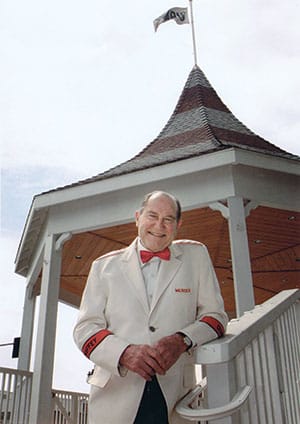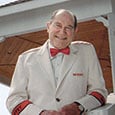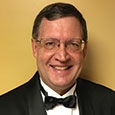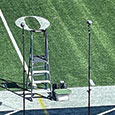Editor’s Note: This article originally appeared in the September 1989 issue of The Instrumentalist.

It all started so innocently. A year after retiring I became homesick for members of my high school band. Nostalgia prompted a “Remember Me” party of alumni and friends. After eating, we sat around recalling the excitement of performing halftime shows, planning concerts, taking overnight trips, waiting for the judges’ decisions…and then it happened.
Bert, a former drum major, had an idea. “Wouldn’t it be great to get an alumni band together? If we could get 10 or 15 of the old gang, would you be willing to direct us?” Suffering from nostalgia, I replied, “Why not?” The subject changed, and soon the evening ended, but not the idea of an alumni band.
The following week, Bert called to report that 26 former Chaffey musicians were eager to start playing again. No longer suffering from nostalgia, I began facing realities. We had no music library, no rehearsal room, and no place to perform.
There was a momentary silence on the telephone. Bert said, “I’ll get back to you,” and hung up.
Three days later the telephone rang again. It was Bert, and his excitement fairly shook the telephone out of my hand. “Well, it’s all settled,” he said. “I talked with the principal of the Chaffey Adult School, and he has agreed to offer band as one of the Adult School classes. Rehearsals will begin in six weeks with the new semester.”
After the initial shock, I was overcome by misgivings. As a public school band director, I had scarcely been aware of community bands, although there were 3 operating within a 20-minute drive from my home. I called the directors of these groups for help and information. All three invited me to bring my horn and get some firsthand experience in the world of community bands.
What an eye-opener. In one group, rehearsals were only loosely organized. Members came to play, but playing was interspersed with a generous amount of socializing, and music was selected for the performer’s and audience’s enjoyment. The audience provided the primary reason for playing, a 180-degree reversal from my 42 years of selecting music for its educational value. This was an important lesson for a fledgling community band director.
The second group I visited was in direct contrast to the first. Membership was by audition only, rehearsals were tightly controlled, and programs were designed to impress the audience with the band’s technical facility. This approach did not invite wide support from the community, however, and musicians frequently outnumbered the audience. I learned a valuable lesson.
The third group was a disaster. The director was late for the rehearsal, members came and went without explanation. I finally packed up my instrument and left with the crowd.
Drawing on these experiences, I began to recognize both the similarities as well as the differences in working with high school students and adults.
Both school and adult musicians are volunteers. The former immediately are regimented into an ongoing system, but the latter consider band a recreational activity.
Students accept the organizational plan as it exists. The adult musician is not bashful and will question any or all organizational formats.
School band members are required or strongly encouraged to attend all rehearsals, performances, and contests. Adult players attend as often as work and family responsibilities allow.
Students are disciplined to expect many hours of rehearsals, but adults do not want to spend too much time rehearsing and polishing music. They want to get on to the next number.
The director is considered a wise and infallible musician by most students; but the adults in a community band see the director as a human being, not an idol to be emulated.
The second semester began, and so did my first rehearsal. As the clock edged toward the 7:00 p.m. rehearsal hour, I became apprehensive. Would anyone really show up? Why in the world had I agreed to become a re-treaded band director? The answer came quickly as players started to arrive. Not 10, not 15, not 25, but 42 enthusiastic alumni began hugging and talking, and talking, and talking. Finally someone suggested that we get down to the business at hand.
What a short rehearsal. Twenty-three minutes after starting to play, we were finished, in more ways than one. After years of neglect, sagging embouchures quickly gave out. We ended the evening remembering old times and promising to practice before the next meeting.
The following week, 10 more alumni found their way back into our ranks. By the third rehearsal, I could almost recognize the music the group was playing. The principal of the school was so enthusiastic about our progress that he sent notices inviting the teachers to bring their classes to a special concert being given by the Chaffey Adult Band. It was a captive audience; we were on our way.
A community band should have a friendly atmosphere. Members new to our community have expressed surprise at the family atmosphere prevailing at our rehearsals and concerts. One woman said that she had been shy about joining a community music group but was pleased to find that our organization placed more emphasis on people than on musical expertise.
When new musicians join the group, they fill out a short questionnaire stating their name, address, telephone number, and birth date, and giving a short autobiographical sketch. A birthday committee is responsible for light refreshments at those rehearsals that coincide with a member’s birthday. This festivity takes place during the break and helps build a warm atmosphere.
Our community band is open to all adults regardless of their musical ability; we hold no auditions. If a person has an instrument and the desire to play, he or she becomes a member simply by attending rehearsals and concerts. Although this policy is nice for the participants, it does have the drawback of creating a wide range of ability levels. I have come up with three solutions to overcome this major flaw.
Keep your group in mind. Choosing music to suit your group is important. Students and adults easily become discouraged when the music is too difficult or too easy for them to play. Determining the average ability level and choosing selections slightly below that level minimizes this problem. It also reduces time and builds confidence in the players.
Select composers and arrangers who know how to write for the young band, avoiding technical difficulties yet making the music exciting for both audience and performers. Look for arrangements that use generous cross-cueing for oboe, bassoon, bass clarinet, French horns, and other instruments you may lack.
Feature soloists. Certain sections in most band music contain passages that can be played by one musician or a small ensemble, allowing individuals to stand up and be featured. The length of the showcase can be as short as 8 measures or as long as 32. The idea is to give all members of the band a chance to be featured in each concert, whether they are solo players or sit in the back row of clarinets.
Weak players can stand with the section being showcased, while strong players are individually featured. Musicians find this recognition stimulating, and audiences enjoy the added flair that showing off soloists gives to a band’s performance.
Feature sections. Another technique that helps weaker players improve is to assign a section solo or an ensemble part to every person in the band, with the goal of performing the music at an undetermined future concert. Members know that their moment in the spotlight may come at any time during the season, a strong incentive for outside practice.
With million-dollar talent offered free on T.V., attracting an audience is a major concern for the community band. The usual newspaper announcements, radio plugs, posters, and handbills all help. However, another approach works well to target special segments of the community.
Over the years, we have developed a growing audience in the 50+ age group. Senior citizens living in mobile home parks and retirement villages are always looking for new things to do and places to go. Our publicity staff contacts the recreational directors of local parks and provides handbills for distribution to their tenants. Many parks own a van to transport members to special events, and a free concert makes an attractive outing.
To broaden the target audience and attract other segments of the population, we use a theme for each concert. Some successful themes have been:
• Best of the Big Bands
• Best of Broadway
• Best of Hollywood
• Best of Rock and Roll
• A Salute to Veterans
• Concert for Lovers
• Senior Citizen Christmas Festival
• Meet the Band
• America, The Beautiful
• I Love You, Mother
In our community, audiences appreciate some preliminary background on the selection to be performed. We use a master of ceremonies to provide this information as well as to keep personal contact with our listeners.
Our concerts are informal. We invite audience participation by encouraging spontaneous applause during numbers in which soloists or ensemble groups are featured. This format is familiar both to the older groups who remember the big band era and to the younger generation who delight in a constant show of appreciation during a performance.
To prevent listeners from becoming restless because a selection is too long, we edit all numbers to last only 3-5 minutes. This allows a wide variety of music and a refreshing change of pace. After all, T.V. is a hard act to follow.
Money is always available for a band that serves its community. Parks and Recreation departments, the Chamber of Commerce, music stores, newspapers, the City Council, or adult schools such as Chaffey are all possible sponsors. We schedule 10 concerts each year, and our sponsoring groups allow us to be paid for additional programs if the cash donations are used to expand the music library.
Members of the band represent a cross-section of the professions. There are Ph.D.’s, music teachers, auto mechanics, medical doctors, realtors, and so on. With this wide representation from 17 neighboring communities, we get good results from encouraging band members to offer our services to groups in their areas looking for entertainment. When asked how much a performance costs, the standard answer is, “We do not charge a fee but welcome a donation for our music library. A special one-hour program for your group requires 12-14 band arrangements. Each arrangement costs $40-$60. The music for your program has cost the band $500-$600; however; since this music can be used over again, we can accept a much smaller donation. We will leave the amount up to you.”
This policy has been a winner, bringing in donations ranging from $100 to $600. Everyone wants to help expand the band’s music library.
For a recent concert given at Disneyland, we did not have money to buy band uniforms, so each member wore a white shirt or blouse, dark trousers or skirts, and a black bow tie. At the end of the program, a Disneyland representative complimented our performance but ended by saying, “It’s too bad the group doesn’t look as well as it sounds.” In my next budget request I quoted this Disney-land official, and the following year’s allotment included $2,000 extra toward uniforms.
Over these last years of directing a community band, I have recognized the need for adults to participate in music both as performers and as listeners. Adult musicians who remember the satisfaction of performing in high school or college bands get another chance to relive these performances. With the growing number of retirees, more people have leisure time available and look for the kind of wholesome entertainment that a community band offers.
Even my objectives have changed. I no longer search for educational materials; I concentrate on finding music that the adults in my band will have fun playing and the adults in my audience will find enjoyable.
I am concerned that our programs are interesting and polished, as far as that is possible with one rehearsal a week. I have learned to accept occasional intonation problems and rhythmic insecurities, but our musical family is satisfied with their performances and so are our audiences. As part of this family, I couldn’t be more proud.





